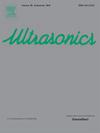空气中超声非线性谐波的产生在超宽频率范围内表征薄膜
IF 3.8
2区 物理与天体物理
Q1 ACOUSTICS
引用次数: 0
摘要
空气耦合超声方法允许对多孔材料进行快速和无创的表征,直接从其超声响应中提取有关其性能和结构的有价值信息。然而,在某些情况下,如果在较宽的频率范围内进行测量,则精度和信息量都可以增加。根据所采用的转导技术,这可能是一个显著的限制。特别是,pmut和cmut的使用更适合扩大该技术的工业部署,因为这些传感器在空气中运行时通常是窄带和低频换能器。为了使低频和窄带换能器能够用于空气耦合超声过滤膜的表征,我们建议利用空气中的大振幅窄带和低频信号以及非线性谐波产生。为了验证这种方法的潜力,我们通过使用不同的激励和设置配置来应用所提出的技术对几种滤波材料进行了表征,包括不同的超声波传感器:高灵敏度和宽带自制压电换能器(235 kHz, 650 kHz和1000 kHz);窄带、低频和低成本换能器(弯曲40 kHz和径向120 kHz);以及一种基于PVDF薄膜自制的超宽带接收机。将得到的结果与传统的线性宽带空气耦合超声测量结果进行了比较,这使我们能够验证这种方法。这项创新预计将对超声波技术的适用性产生积极影响,因为它将简化测量过程,使其在设备需求和所需时间方面要求较低。本文章由计算机程序翻译,如有差异,请以英文原文为准。
Ultrasonic non-linear harmonic generation in air for the characterization of thin membranes over an ultra-wide frequency range
Air-coupled ultrasonic methods allow for the rapid and noninvasive characterization of porous materials extracting valuable information regarding their performance and structure directly from their ultrasonic response. Nevertheless, in some cases, both the accuracy and the amount of information can be increased if measurements are taken over a wide frequency range. This can be a significant limitation depending on the transduction technology to be employed. In particular, for the use of PMUTs and CMUTs that are better suited for scaling up industrial deployment of this technology, as these are, typically, narrowband and low frequency transducers when operated in air. To enable the use of low-frequency and narrowband transducers for the characterization of filtration membranes using air-coupled ultrasound, we propose to make use of large amplitude narrowband and low frequency signals and non-linear harmonic generation in the air. To validate the potential of this approach, we characterized several filter materials by applying the proposed technique using different excitation and setup configurations including different ultrasonic sensors: high-sensitivity and broadband piezoelectric self-made transducers (235 kHz, 650 kHz and 1000 kHz); narrowband, low-frequency and low-cost transducers (flexural 40 kHz and radial 120 kHz); and an ultra-wideband receiver self-fabricated based on PVDF film. The results obtained were compared with conventional linear wideband air-coupled ultrasonic measurements, which allowed us to validate this approach. This innovation is expected to have a positive impact on the applicability of ultrasonic techniques, as it will ease the measurement process being a less demanding alternative in terms of equipment needs and time required.
求助全文
通过发布文献求助,成功后即可免费获取论文全文。
去求助
来源期刊

Ultrasonics
医学-核医学
CiteScore
7.60
自引率
19.00%
发文量
186
审稿时长
3.9 months
期刊介绍:
Ultrasonics is the only internationally established journal which covers the entire field of ultrasound research and technology and all its many applications. Ultrasonics contains a variety of sections to keep readers fully informed and up-to-date on the whole spectrum of research and development throughout the world. Ultrasonics publishes papers of exceptional quality and of relevance to both academia and industry. Manuscripts in which ultrasonics is a central issue and not simply an incidental tool or minor issue, are welcomed.
As well as top quality original research papers and review articles by world renowned experts, Ultrasonics also regularly features short communications, a calendar of forthcoming events and special issues dedicated to topical subjects.
 求助内容:
求助内容: 应助结果提醒方式:
应助结果提醒方式:


